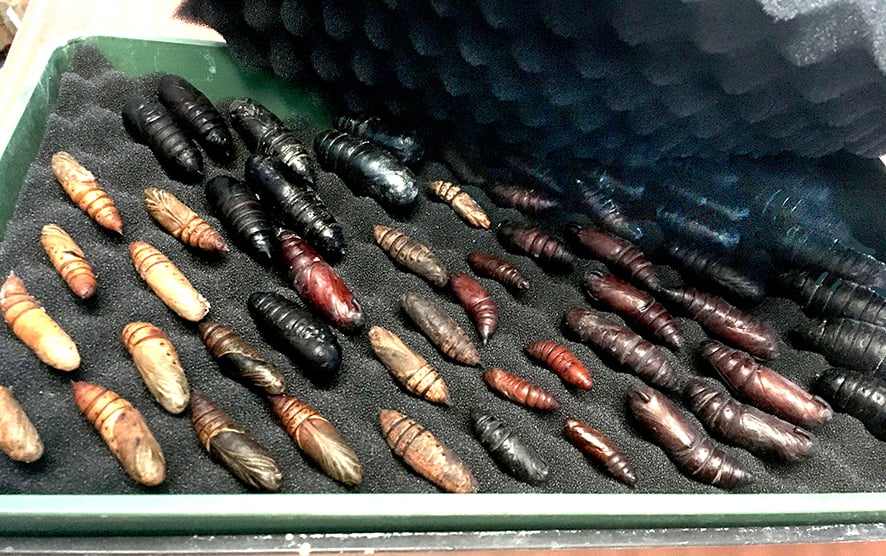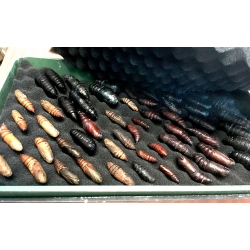- Current EGGS and LARVAE (54)
- EXOTIC BUTTERFLY PUPAE (11)
- MARKET STALL Everything a BARGAIN! (22)
- XXP super fast EXPRESS COURIER DELIVERY (2)
- CURRENT PUPAE - Chrysalides and cocoons (45)
- SILKWORM EGGS and Silkworms (6)
- SPRING and SUMMER EGGS and LARVAE Order now for supply in season (73)
- SPRING and SUMMER PUPAE You can order these NOW in advance (25)
- GIFT SUGGESTIONS (29)
- WINTER PUPAE for breeding in the following season (30)
- CAGES (10)
- PHASMIDS Leaf & Stick Insects, Mantids and more (2)
- SCHOOLS Recommended Livestock (14)
- SLEEVES for REARING LARVAE (7)
- PLASTIC REARING CONTAINERS (2)
- EQUIPMENT (29)
- MOTH TRAPS (7)
- NETTING (3)
- BOOKS (39)
- CHARTS (21)
- SPECIMENS for collectors (151)
- SILK Yarn, Fibres, Silkworm eggs (7)
PUPAE NEST
The Pupae Nest, using sheets of bobble foam, is the innovative method used by WWB to keep subterranean pupae, in particular, and other pupae and cocoons in ideal conditions in the emerging cage.
• Developed specifically for underground pupae: also ideal for cocoons and unattached pupae.
• Immediate access to pupae for inspection, without disturbance.
• Provides healthy and moist conditions.
• Easy observation of pupae that are forming up prior to emergence.
• Allows the breeder to anticipate the emergence of required males or females.
• Ensures hygiene and avoidance of harmful bacteria.
This method has proved to be better than using soil or compost, because it enables instant inspection whenever required, for removal of empty pupal shells or any dead pupae, and to be able clean up, with minimum disturbance of the pupae. The pupae rest in the depressions, in natural conditions of humidity and hygiene. If they were on plain foam sheets they would roll around, and would be less able to benefit from the humidity assisted by the depressions, which also provide separation. The covering sheet of foam is placed with the bobble side down, so both of the indented sides are together, which allows some airflow and eases the passage for adults to emerge and climb to dry their wings.

The pupae and foam should be sprayed thoroughly (not just misted) every day, or more often in higher temperatures. If already moist when you next come to spray, you can reduce or omit further spraying. The pupae and foam should be sprayed thoroughly (not just misted) every day, or more often in higher temperatures. If already very moist when you next come to spray, you can reduce or omit that day's spraying. The base of the upper tray is perforated to allow drainage. It rests in an unperforated tray with a block to separate the two trays and receive the drained water. This drainage allows liberal watering, without risk of the pupae lying in water.
Cocoons also do well resting on a bobble foam sheet, usually without another sheet covering them, though in exceptionally hot conditions, a moist foam sheet on top of the cocoons, helps to maintain humidity. Cocoons require very liberal watering, not a just a fine mist. Soak them thoroughly, safe in the knowledge that they are well drained.
Butterfly pupae, which in the wild are not formed underground, are usually fixed to a twig or other surface, either hanging from the tail cremaster, or (dependent on their family) upright and held in place by a silken girdle. You can go to the trouble of emulating this artificially (the way to suspend pupae is described in the Exotic Butterfly Pupae section) or they can be laid on the surface of the foam and not covered. As long as they are misted to avoid them drying out, the butterfly usually forms successfully in such pupae laid on foam, and the porous surface helps give the emerging butterfly the grip needed to pull itself out of the chrysalis shell, and crawl to the netting wall of the cage to expand and dry its wings.
From time to time, it is good practice to remove the pupae, wash the foam thoroughly, spray with dilute bleach (about 10% solution, which is not harmful to the pupae) then replace the pupae on nice wet foam. In summer the foam is normally washed about every 2- 3 weeks, using hot water with a touch of bleach added, but without soap or detergent which would create problems with froth and would take too long to rinse away. The washing interval depends on the extent of hatching activity and temperature. Any hint of smell, or slippery feel to the pupae, indicates bacteria, and means that washing is overdue. When adults emerge from the pupa, a waste product Meconium, is ejected. This is only harmful if left so long that it spoils the freshness and encourages bacteria. Empty pupal shells and any other organic matter, are best frequently removed, to avoid build-up of mould or bacteria. In the emerging cage, pupae that are crowded together can develop a slime, caused by bacteria, which slows development and can kill pupae. Pupae nests help to eliminate such risk and periodic washing gives maximum hygiene.
When washing the foam sheets, it is also important to wash and disinfect the two trays. If you are incubating quite a lot of pupae it makes it more convenient to have two Pupae Nests, so you can move the pupae straight into a prepared clean Nest. To encourage this, there is a price reduction for two nests bought together.
TO INCUBATE pupae and COCOONS An emerging cage should have netting sides with plenty of ventilation. This provides grip for emerging adults, and you can add some sticks. In summer conditions, you can incubate temperate pupae at room temperature, without further heating, but when it is cool you may wish to add warmth. When you heat, the ambient temperature can be raised to 25º over a few days, and increase further to 30º if required. The air around the cage needs to be heated: they don’t do so well if heat is directed at the pupae or the cage. Don't stand the cage on a heat source. You cannot over-water the cocoons as long as they are able to drain. You can hang cocoons: if you do they then need more frequent and heavy watering.
The Pupae Nest is based on standard seed tray size 24 x 38 cms which fits the Standard Pyjama Cage.

Exotic butterfly pupae should be incubated, totally shaded, in a tropical greenhouse. The ambience of a tropical greenhouse is not easy to emulate. Some breeders are successful in re-creating such conditions, but it us not sufficient simply to achieve a high temperature and humidity. For details of how to attach tropical butterfly pupae to twigs, or bamboo, please see the introduction to the Exotic Butterfly section of the WWB website. Exotic butterfly pupae that are not suspended but lying loose, can be laid on the bobble foam of a Pupae Nest, and left uncovered. Remember incubating pupae must always be in full shade.







